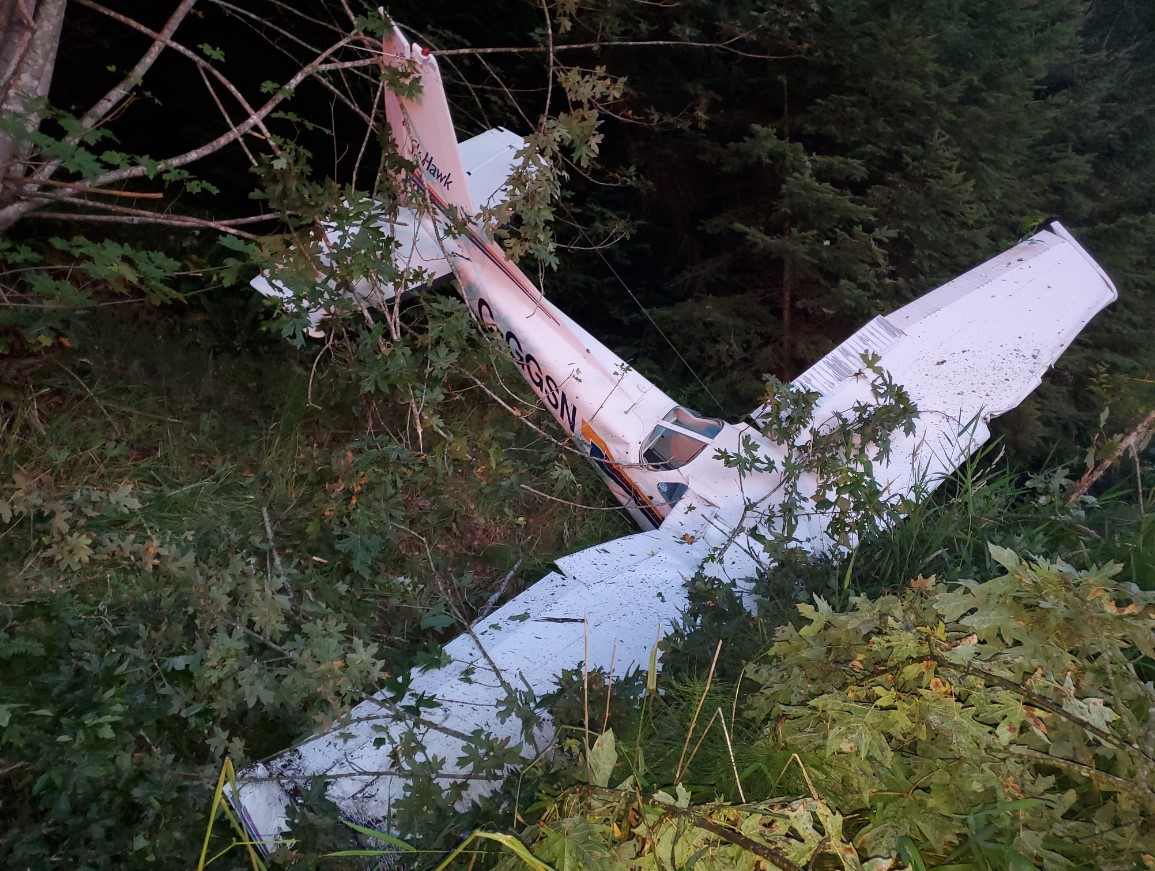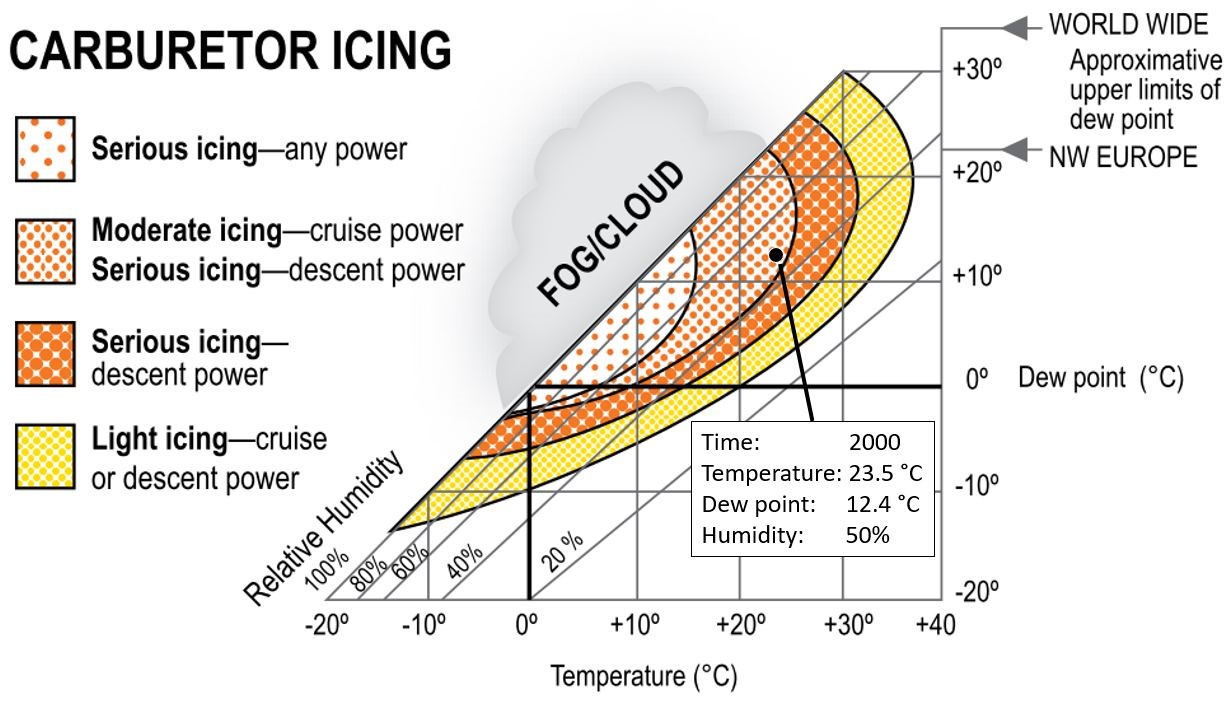Collision with terrain
Privately registered
Cessna 172P, C-GGSN
Qualicum Beach Airport, British Columbia
The Transportation Safety Board of Canada (TSB) investigated this occurrence for the purpose of advancing transportation safety. It is not the function of the Board to assign fault or determine civil or criminal liability. This report is not created for use in the context of legal, disciplinary or other proceedings. See Ownership and use of content. Masculine pronouns and position titles may be used to signify all genders to comply with the Canadian Transportation Accident Investigation and Safety Board Act (S.C. 1989, c. 3).
History of the flight
On 24 July 2022, the privately registered Cessna 172P aircraft (registration C-GGSN, serial number 17274207) was conducting a recreational visual flight rules flight from Victoria International Airport (CYYJ), British Columbia (BC), to Qualicum Beach Airport (CAT4), BC. Before the flight, 18 U.S. gallons of 100LL aviation grade fuel were added to the aircraft at CYYJ, after which a total of 30 U.S. gallons of fuel was onboard.
At approximately 1857,Footnote 1 after the pilot had conducted the walkaround inspection and run-up checks, the aircraft departed CYYJ with only the pilot on board. The aircraft flew at a cruising altitude between 2300 and 2500 feet above ground level (AGL) for approximately 27 minutes. During the approach to CAT4 from the southeast, the pilot conducted a reduced power descent, first to 2000 feet AGL, then to 1300 feet AGL. Shortly after the aircraft had levelled off at 1300 feet AGL, the pilot increased throttle and the engineFootnote 2 began to sputter and its speed decreased from approximately 2300 rpm to 1200 rpm. The pilot further increased throttle, but the engine did not respond. The engine fuel mixture was set to full rich for the duration of the flight and carburetor heat was not applied at any time.
The pilot had been manoeuvring to join the downwind leg for Runway 29, but opted to conduct an emergency landing on Runway 11 and announced his intention on the airport’s mandatory frequency. The pilot initiated a left turn, reduced throttle, added full flaps, and entered a forward slip in a steep descent. At 1938:28, the aircraft briefly contacted the surface of Runway 11 beyond Taxiway C (at which point less than 1850 feet of runway remained) and became airborne again. The pilot initiated a go-around and increased the throttle to full power, raised the flaps, and the aircraft entered a climb. Approximately 19 seconds after the initial touchdown, the pilot initiated a steep right turn immediately before reaching tree-covered, down-sloping terrain, and the aircraft began a rapid descent in a right bank and nose-down attitude. The pilot declared a MAYDAY on the airport’s mandatory frequency and the aircraft impacted terrain in the trees along the edge of a farmer’s field (Figure 1).
The 406 MHz emergency locator transmitter activated and local emergency services arrived on scene shortly after. The pilot received serious injuries and was transported to hospital by air ambulance. The aircraft was substantially damaged.
Pilot information
The pilot held a commercial pilot licence – aeroplane, issued on 13 March 2022, and had a valid Category 1 medical certificate.
The pilot had accumulated 289.7 total flying hours, 116.2 hours of which were as pilot-in-command. He had flown 11.8 hours in the 90 days before the occurrence flight, which was his first flight since 27 June 2022. The pilot had last flown a Cessna 172 aircraft on 24 April 2022.
Aircraft information
The Cessna 172P aircraft is a single-engine, high-wing, all-metal monoplane equipped with a carbureted Avco Lycoming O-320-D2J engine, a McCauley all-metal, 2-bladed, fixed-pitch propeller, and fixed tricycle landing gear.
The occurrence aircraft had accumulated approximately 21 463.2 total air time hours and was being rented by the pilot.
The investigation revealed that a pilot had reported a rough-running engine on the right magneto 52.9 air time hours before the occurrence. However, an aircraft maintenance engineer was unable to duplicate the fault during an engine run-up on the ground, and the aircraft was returned to service.
The aircraft had undergone an annual inspection, including the removal and repair of the No. 2 and No. 3 cylinders, 8.3 hours before the occurrence.
The aircraft was being operated within its weight and balance limitations.
Meteorological information
Environment and Climate Change Canada’s weather station at CAT4 records hourly weather information. The information recorded at 2000 indicated the following:
- Winds from 300° true (T) at 7 knots
- Temperature 23.5 °C, dew point 12.4 °C
- Relative humidity 50%
An aerodrome routine meteorological report (METAR) for Nanaimo Airport (CYCD), BC, located 26 nautical miles east-southeast of the accident site, indicated the following weather at 2000:
- Winds from 330°T, variable to 030°T, at 3 knots
- Visibility 30 statute miles
- Broken ceiling at 25 000 feet AGL
- Temperature 27 °C, dew point 11 °C
- Density altitude 1400 feet
Aerodrome information
CAT4 has 1 runway surface (Runway 11/29), which is 3564 feet long and has thresholds that are displaced by 485 feet and 200 feet respectively. The abbreviated precision approach path indicator (APAPI) angle is set at 4.5° for both ends of the runway.
The Canada Flight Supplement entry for CAT4 includes a caution note informing pilots that 100-foot-tall trees are located approximately 3000 feet beyond the threshold of Runway 29.Footnote 3
Wreckage and impact information
The aircraft was found approximately 1880 feet from the end of Runway 11, at the edge of a privately owned famer’s field that is approximately 100 feet below the runway elevation (Figure 2).
The aircraft initially contacted trees at approximately 22 feet AGL. It came to rest on the sloped bank on a west-southwest heading, at a 62° nose-down attitude in a water-filled ditch that was approximately 12 to 24 inches deep.
The forward fuselage was significantly deformed from the impact and 3 of the 4 engine mounts were severed. The remainder of the aircraft was largely intact; however, the right-wing strut had separated from the fuselage and the right landing gear had rotated 180°. Both wing flaps were found retracted. The propeller was embedded in the ditch with 1 blade significantly bent aft and no damage to the second blade. This type of damage is consistent with the engine producing low power or not operating on impact. Continuity of the flight and engine controls was confirmed.
First responders noted that fuel was initially leaking from the right wing; TSB investigators recovered approximately 4.5 U.S. gallons of fuel that remained in the aircraft and noted the fuel as being 100LL aviation grade fuel, which was clean and bright.
Engine examination
The engine was removed from the aircraft for a detailed examination and teardown. Despite minor impact damage, the overall condition of the assembled engine was unremarkable and the crankshaft rotated normally. The magnetos were synchronized with each other, the engine timing was correct, and all spark plugs operated normally. The carburetor was disassembled with no faults found. The filters and the screens from the oil and fuel systems were found clean and unobstructed. The examination found 2 anomalies of note:
- The right magneto was firing intermittently below 1800 rpm.
- The oil sump contained significant magnetic metal particles.
The right magneto was disassembled and signs of wear were evident on the carbon brush, distributor block electrodes, and contact points. It was also noted that the centre brass electrode was found loose on the centre steel shaft. The impulse coupling was operating normally. It is unlikely that the intermittent firing of the magneto would have significantly degraded engine operation.
The metal particles found in the oil sump could not be sourced to the failure or absence of an internal engine component. There were no signs that the particles caused secondary damage to the internal engine components or precluded the engine from operating.
Survival aspects
In this occurrence, the aircraft remained upright and the fuselage maintained a survivable space for the pilot.
Both of the occurrence aircraft’s front seats were fitted with a safety belt consisting of a lap belt and a shoulder harness. First responders found the pilot’s seat (left side) secured to the floor and the pilot secured with the lap belt only. Upon further examination, the investigation determined that the shoulder harness was secured to the lap belt buckle, but the stitching of the harness webbing had failed at the aft anchor bracket. As a result, the shoulder harness webbing pulled through the bracket during the impact sequence.
In accordance with the Canadian Aviation Regulations, safety belts are to be inspected every 12 months “for poor condition, fraying, and any other apparent defects.”Footnote 4 The occurrence aircraft’s safety belts were inspected 10 days before the occurrence, during the aircraft’s annual inspection. There is no service life limit for the safety belts installed on the occurrence aircraft.
The Canadian Aviation Regulations also require that “each separate part of the safety belt assembly must be permanently and legibly marked.”Footnote 5 The occurrence aircraft’s lap belts each had an attached label that included the rated strength of the belt; however, the shoulder harness did not have a label.
Carburetor icing
The Cessna 172P Pilot Operating Handbook (POH) states that carburetor ice may result in “[a] gradual loss of RPM and eventual engine roughness.”Footnote 6 To prevent carburetor icing, the POH includes the application of carburetor heat on various checklists. In the Normal Procedures section of the POH, carburetor heat is included on both the Descent and the Before Landing checklists.Footnote 7 In the Emergency Procedures section of the POH, it is included on the Engine Failure During Flight checklist.Footnote 8 For the duration of the occurrence flight, the carburetor heat was in the OFF position.
The Transport Canada Aeronautical Information Manual provides guidance material and a reference chart for weather conditions that can induce carburetor icing (Figure 3). The formation of carburetor ice can occur at all engine power settings and can vary with specific engine installations.
Based on the weather conditions recorded closest to the time of the occurrence at CAT4, carburetor icing was charted as moderate icing during cruise power and serious icing during descent power.
Environmental impact
The water-filled ditch where the aircraft came to rest was part of the neighbouring French Creek watershed. Following the release of oil and fuel from the aircraft, the area underwent an extensive environmental rehabilitation that included removal of contaminated water and soil.
TSB laboratory report
The TSB completed the following laboratory report in support of this investigation:
- LP065/2022 – NVM Recovery – iPad
Safety message
Based on the conditions at the time of the occurrence, there was a potential for serious carburetor icing at descent power. Even though the investigation was unable to determine if carburetor icing was a factor in this occurrence, pilots are reminded that carburetor icing can occur even in warm temperatures. Pilots should follow the guidance in their aircraft’s POH with respect to the application of carburetor heat.
This report concludes the Transportation Safety Board of Canada’s investigation into this occurrence. The Board authorized the release of this report on . It was officially released on .


